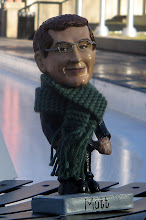 The very first masterclass I attended at last summer's ISB convention was entitled "Bow Strokes with Jeremy McCoy." That might not sound irresistibly attractive to some people, but those people apparently were not in attendance at the 2007 ISB Bass Convention. The room was packed, there were people standing along the wall, and even craning their necks to see from outside the door.
The very first masterclass I attended at last summer's ISB convention was entitled "Bow Strokes with Jeremy McCoy." That might not sound irresistibly attractive to some people, but those people apparently were not in attendance at the 2007 ISB Bass Convention. The room was packed, there were people standing along the wall, and even craning their necks to see from outside the door.We were about to hear Jeremy McCoy demonstrate spiccatto, and we were all pretty damn excited about it.
Jeremy McCoy plays in the Metropolitan Opera Orchestra, and if you don't know his playing, check out his recently released cd "Dialogues with Double Bass". It's an incredible variety of duets for bass and other instruments, showing off Jeremy's musicality as collaborator as well as soloist.
Getting back to the masterclass though - I unfortunately can't offer any sound or video, but I was taking notes. Here are some of Jeremy's guidelines for working on spiccatto, as well as I can remember them:
1. Prepare with long tones - The contact in a bounced stroke is relatively short, so it's especially important to develop immediate, quality core sound. Focus on full contact with flat bow hair, developing the maximum friction in order to start the string vibrating as quickly as possible.
2. Neutral lines - We don't want anything rigidly straight in the bow arm, since that will disrupt the natural springiness of the bow. The wrist and elbow need to have a combination of firmness and suppleness, so they can direct the bounce without overly controlling it - think of the fluid motion of a basketball player dribbling. This will work best with some degree of flexion.
3. The tip must track - Any wobble or wavering in a long or detache stroke will only become more pronounced in an off the string stroke. Watch that the tip follows a consistent, straight path in long tones, so that it can track horizontally in spiccatto strokes. Notice if the motion of up-bows and down-bows is symmetrical, or if one is more pronounced. Again, using full bow hair for maximum friction will help.
4. Find a natural bounce point - This can start with finding the balance point on your bow, and experimenting with bounced strokes in relation to that point. There's no single ideal spot on the bow, but moving away or towards the balance point can help make spiccatto strokes longer or crisper.
5. Initiate with the elbow - Longer strokes might work better with the whole arm, while shorter may mostly involve the wrist and fingers. Any bounced stroke will start with the elbow though - watch that the elbow is preparing and leading the arm and bow.
He went on to demonstrate a whole range of spiccatto strokes, from martele and sautille to ricochet, battute and balzato. I don't actually remember what a balzato stroke sounded like (my notes say "lit. 'prancing' - flicked at top") but it's a fun word to say in rehearsal or at an audition. "Can we hear that a little more balzato, please?"


 Technorati Link Count: no. of blog reactions to this post
Technorati Link Count: no. of blog reactions to this post
1 comment:
I've heard these frequently mentioned - great tips!
Post a Comment